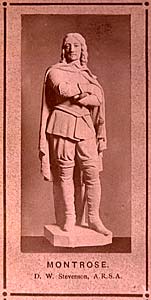 |
Montrose
Found on the south facade of the Scott Monument.
Montrose (from the novel 'A Legend of Montrose', 1819) is depicted
standing with arms folded. He is wearing thigh length boots with
trousers and a tunic, and a knee length cloak.
Scott's admiration for the Royalist commander James Graham (1612
to 1650), 5th Earl and 1st Marquis of Montrose, was enormous.
"His stature was very little above the middle size,
but in person he was uncommonly well-built, and capable both of
exerting great force, and enduring much fatigue. In fact, he enjoyed
a constitution of iron…"
He was "the bravest, the most loyal, the most heroic spirit
among our nobility", and "his soul looked through his
eyes with all the energy and fire of genius".
Disguised as the Earl of Menteith's attendant Anderson, Montrose
journeys north to raise the King's standard in the Highlands in
the summer of 1644. His campaign of that year, and the battles of
Tippermuir, Aberdeen and Inverary, are recounted in the novel, which
ends soon after his great victory over Argyle at Inverlochy in February
1645.
About the Sculptor
David Watson Stevenson (1842 to 1904)
D.W. Stevenson was born in Ratho, Midlothian, on 25 March 1842,
and died in Edinburgh on 18 March 1904. He trained at the Trustees
School and Life School, and later also in Rome, before working under
William Brodie for eight years.
While assistant to Sir John Steell, he did statues of ‘Science’,
‘Learning’ and ‘Labour’ for the Scottish
National Memorial to the Prince Consort in Charlotte Square. His
statue of Robert Burns (1898) is in Bernard Street, Leith. Others
include ‘Sir John Steell when sculptor to Her Majesty for
Scotland’ (1887) and ‘Napier of Murchiston’ (1898)
both now in the Scottish National Portrait Gallery.
Also on the Scott Monument, the figures of Queen Mary, James VI,
Charles I, The Fair Maid of Perth, and Halbert Glendinning.
^ back to the top |



